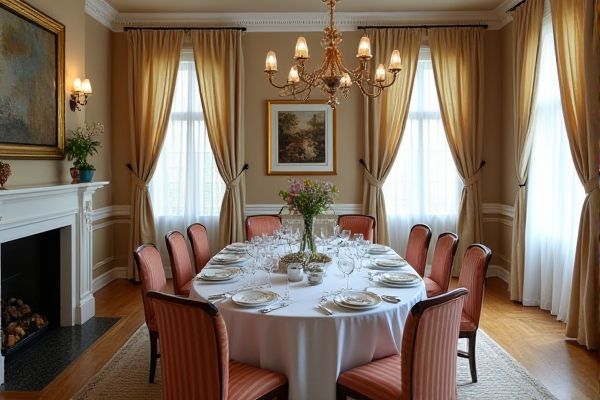
Formal dining involves a structured setting with multiple courses, specific table arrangements, and etiquette rules, creating an elegant and refined atmosphere. Informal dining offers a relaxed, flexible environment suitable for everyday meals or casual gatherings; explore the rest of the article to understand how each style can enhance your dining experience.
Table of Comparison
| Aspect | Formal Dining | Informal Dining |
|---|---|---|
| Setting | Elegant, sophisticated environment | Casual, relaxed atmosphere |
| Tableware | Multiple courses, specialized utensils, fine china | Simple cutlery, everyday dishes |
| Dress Code | Formal attire (suits, dresses) | Casual or smart casual |
| Menu | Pre-planned, multi-course meals | Flexible, varied options |
| Service Style | Waitstaff service, courses served sequentially | Self-service or minimal assistance |
| Occasions | Weddings, business dinners, formal events | Family meals, casual gatherings, everyday dining |
| Time | Longer duration, planned seating | Shorter, flexible timing |
| Etiquette | Strict rules, formal manners | Relaxed social norms |
Introduction to Formal and Informal Dining
Formal dining involves structured etiquette, multiple courses, and carefully arranged table settings emphasizing elegance and tradition. Informal dining prioritizes comfort and simplicity with casual settings, fewer courses, and relaxed manners suited for everyday meals. Both styles serve distinct social functions, catering to occasions from celebratory events to routine family gatherings.
Defining Formal Dining: Key Characteristics
Formal dining is characterized by multiple courses served in a specific order, precise table settings with fine china, crystal glassware, and polished silverware, and etiquette adherence such as proper napkin placement and utensil use. This type of dining often includes a clearly defined seating arrangement and formal attire, emphasizing sophistication and tradition. Your experience in a formal dining setting involves a structured environment designed to impress and facilitate refined social interaction.
Understanding Informal Dining: Main Features
Informal dining emphasizes comfort and convenience, featuring flexible seating arrangements and casual table settings with minimal utensils and dishware. It often includes simple, easy-to-prepare meals served family-style or buffet, encouraging relaxed social interaction. The atmosphere prioritizes warmth and spontaneity, contrasting with the structured etiquette and elaborate presentation of formal dining.
Ambiance and Atmosphere: Formal vs Informal
Formal dining creates an elegant ambiance with refined table settings, subdued lighting, and structured seating arrangements that emphasize sophistication and etiquette. Informal dining fosters a relaxed atmosphere featuring casual decor, flexible seating, and a warm, inviting environment that encourages comfort and easy conversation. Your choice between these dining styles shapes the overall mood, influencing guest experiences and interactions.
Table Setting Differences
Formal dining table settings feature multiple courses of flatware arranged in the order of use, fine china, crystal glassware, and neatly folded cloth napkins, creating an elegant and structured ambiance. Informal dining settings use fewer utensils, simple plates, casual glassware, and often paper or casual fabric napkins, prioritizing convenience and comfort. The placement of utensils, glassware, and dinnerware reflects the complexity and etiquette expected in formal dining compared to the relaxed and flexible nature of informal dining arrangements.
Dress Code Expectations
Formal dining dress codes demand elegant attire such as tuxedos, evening gowns, or cocktail dresses, reflecting sophistication and strict adherence to social etiquette. Informal dining allows more relaxed clothing, including smart casual or business casual outfits, prioritizing comfort while maintaining neatness. Understanding dress code expectations enhances guests' experience and aligns with the event's ambiance and cultural norms.
Menu Style and Course Structure
Formal dining features a pre-planned multi-course menu with specific dishes served in a set sequence, often including appetizer, soup, salad, main course, and dessert. Informal dining offers a more flexible menu style, allowing guests to choose from a variety of dishes without a strict course order. Course structure in formal dining emphasizes timing and presentation, while informal dining prioritizes convenience and casual serving.
Etiquette and Guest Behavior
Formal dining etiquette requires guests to adhere to specific table manners such as using the appropriate utensils for each course and following a structured seating arrangement, demonstrating respect and sophistication. In informal dining, guest behavior is more relaxed, allowing for casual conversation and flexible use of cutlery, fostering a comfortable and friendly atmosphere. Understanding these distinctions ensures guests navigate social dining settings appropriately, enhancing the overall dining experience.
Pros and Cons of Each Dining Style
Formal dining offers an elegant atmosphere ideal for special occasions, featuring multiple courses and refined table settings that enhance guests' experience, but it can be time-consuming and requires strict etiquette which may intimidate some diners. Informal dining provides a relaxed and flexible environment suitable for everyday meals, allowing casual interactions and quicker service, though it may lack the sophistication and structure desired for upscale events. Balancing the pros and cons, formal dining excels in creating memorable, polished experiences, while informal dining prioritizes comfort and convenience.
Choosing the Right Dining Experience
Selecting the right dining experience depends on the occasion and your desired atmosphere, with formal dining offering structured settings, multiple courses, and etiquette-driven interactions ideal for special events or business dinners. Informal dining provides a relaxed environment with casual table settings and flexible menus, perfect for everyday meals or social gatherings with friends and family. Understanding the nuances between formal and informal dining helps you create memorable experiences tailored to your guests' comfort and the event's purpose.
 homyna.com
homyna.com